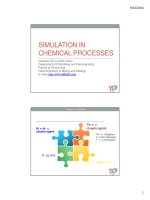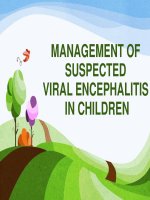Microsoft PowerPoint Gastrointestinal bleeding in children
Bạn đang xem bản rút gọn của tài liệu. Xem và tải ngay bản đầy đủ của tài liệu tại đây (123.55 KB, 11 trang )
Upper gastrointestinal bleeding
in children
Nguyễn Diệu Vinh, MD
Department of Gastroenterology
INTRODUCTION
• Upper gastrointestinal (UGI) bleeding : arising
proximal to the ligament of Treitz in the distal
duodenum, commonly presents with
hematemesis and/or melena.
• The incidence : not well established in children, #
20 % of all episodes of gastrointestinal bleeding
in children.
• The most common causes of UGI in children vary
depending upon age
• The most common cause of severe UGI bleeding
in children : Variceal rupture & ulcer bleeding
Approach to upper gastrointestinal
bleeding in children
• The initial evaluation : assessment of
hemodynamic stability & the necessity for
fluid resuscitation
• Nasogastric or orogastric lavage : performed in
pts with clinically significant UGI bleeding.
Lavage using ice water is not recommended
Resuscitation
Ulcer bleeding
Blood transfusions should be administered to a patient
with a hemoglobin level of 7g/dL or less (IC)
Active variceal hemorrhage
• Acute GI hemorrhage in a patient with cirrhosis, blood
transfusions to maintain a hemoglobin of 8g/dL (IB)
Pharmacologic Management
Ulcer bleeding
• Preendoscopic PPI therapy may be considered to downstage
the endoscopic lesion & decrease the need for endoscopic
intervention but should not delay endoscopy (1B)
• An intravenous bolus followed by continuous-infusion PPI
therapy should be used to decrease rebleeding and mortality
in patients with high-risk stigmata who have undergone
successful endoscopic therapy (IA)
Active variceal hemorrhage
• Somatostatin or its analogues..should be initiated as soon as
variceal hemorrhage is suspected and continued for 3-5 days
after diagnosis is confirmed (IA)
Endoscopic Management
Upper endoscopy should be performed : acute severe
hemorrhage, low-grade persistent, recurrent hemorrhage
Ulcer bleeding
• Clips, thermocoagulation, or sclerosant injection should be
used in patients with high-risk lesions, alone or in
combination w epinephrine injection (1A)
• Routine second-look endoscopy is not recommended (IIB)
Variceal hemorrhage
• EGD, performed within 12 hours, should be used to make
the diagnosis and to treat variceal hemorrhage, either with
EVL or sclerotherapy ( IA)
Ulcer bleeding
• Patients with bleeding peptic ulcers should be
tested for H. pylori & receive eradication
therapy if it is present, with confirmation of
eradication (IA)
• Negative H. pylori diagnostic tests obtained in
the acute setting should be repeated (IB)
Ulcer bleeding
Postdischarge, ASA & NSAIDs
• In patients with previous ulcer bleeding who require an
NSAID, treatment with a traditional NSAID plus PPI or a
COX-2 inhibitor alone is still associated with a clinically
important risk for recurrent ulcer bleeding (IB)
• In patients with previous ulcer bleeding who require an
NSAID, the combination of a PPI and a COX-2 inhibitor is
recommended to reduce the risk for recurrent bleeding
from that of COX-2 inhibitors alone (IB)
Variceal bleeding : Primary prophylaxis
• All patients with cirrhosis undergo diagnostic
endoscopy to document the presence of varices & to
determine their risk for variceal hemorrhage (IIB)
• In patients at high risk of variceal hemorrhage. Non
selective beta-blockers (propranolol or nadolol) or
EVL may be recommended for the prevention of first
variceal hemorrhage ( I A)
• In patients who have high risk varices & have
potential contraindications to beta blockers or have
been intolerant to beta blockers, we suggest EVL (I A)
Secondary prophylaxis
• Patients with cirrhosis who survive an episode of active variceal
hemorrhage should receive therapy to prevent recurrence of
variceal hemorrhage (secondary prophylaxis) (IA)
• Combination of non selective –beta blockers plus EVL is the best
option for secondary prophylaxis of variceal hemorrhage (IA)
• TIPS should be considered in patients who are Child A or B who
experience recurrent variceal hemorrhage despite combination
pharmacological & endoscopic therapy (IA)
• Patients who are otherwise transplant candidates should be
referred to a transplant center for evaluation(IC)
References
UPTODATE VERSION 19.1 (2011)
Approach to upper gastrointestinal bleeding in children
CLINICAL GUIDELINES (2011)
International Consensus Recommendations on the
Management of Patients With Nonvariceal Upper
Gastrointestinal Bleeding
AASLD PRACTICE GUIDELINES (2007)
Prevention and Management of Gastroesophageal
Varices and Variceal Hemorrhage in Cirrhosis









